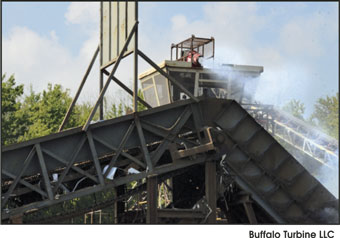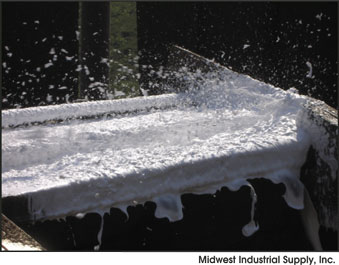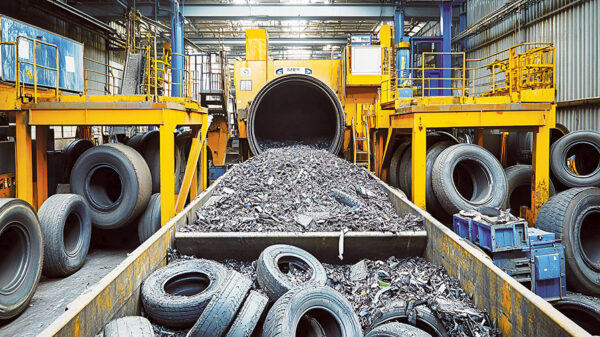by MARY M. COX
Manufacturer List
|
It is no secret that waste and recycling settings are typically quite dusty and gritty for those who labor there. One aspect of that situation usually involves air quality. Dust control can be addressed through a variety of methods and products.
According to Brian Singer, sales and marketing of Buffalo Turbine, “Buffalo Turbine manufactures dust and odor control machines which are made using high-precision machined components, resulting in long lasting dependable products.” The firm’s products are used worldwide in a variety of applications. Popular applications include demolition sites, construction sites, recycling facilities, landfills, aggregate processing, waste transfer stations, and many more. Diesel, gas, electric, PTO driven and hydraulic models are available. “The diesel and gas machines are the most popular because they offer oscillation, for a larger cover area and are self-contained machines which make it easy to maneuver around the sites. Being able to maneuver the machine around the facility is essential, especially in areas that are open and subject to shifting air flow. At indoor facilities, visibility and breathing conditions are top priorities for employers who want to keep employees safe from both short and long term harm. Minimal set up time makes these machines even more convenient. Minimal daily maintenance also aids in continued production, and so avoids downtime,” Singer explained.
Buffalo Turbine machines function by introducing water to a gyratory atomizing nozzle (GAN). The power of the turbine air then pushes the atomized water into the air. This creates droplet sizes of 50 to 200 microns, which matches dust particle size, bringing fugitive dust to the ground. Singer noted, “Dust control is not only a necessity for employee safety but also relative to government regulations intended to protect those in adjacent neighborhoods from fugitive dust created by a facility. Facilities can incur large fines if they produce dust to the extent that it migrates to other properties and without dust control, production slow down can also result.”
Fogco has 28 years of experience manufacturing and designing high pressure fog systems for a variety of applications and industries. For dust and odor concerns, “Fogco has multiple options that will provide solutions for any size or type of facility,” Dana Pack, vice president of sales stated. For indoor applications, the firm manufactures static overhead line systems that can be designed on a grid to suppress dust and also eliminate odors when injecting a neutralizer into the system. Pack said, “Fogco’s proprietary line of fan products is an effective alternative to standard line systems because the high pressure fog is dispersed horizontally at 360°. This technique improves distribution and consistency in covering an area. For large, outdoor needs, we offer a line of fog cannons that can throw fog from 50 to 300’. With recent changes to compliance regulations around silica in demolition and construction, we’ve seen an increased demand for dust suppression solutions in these settings.

“Companies continue to face challenges with increased regulations involving dust and odor concerns. Fines can be severe for firms that do not equip their facility with a properly designed system that complies with industry requirements. Worker safety and productivity can be also impacted if an unhealthy environment is not corrected.”
Pack believes that if state and federal compliance regulations increase, more business owners will be proactive with these challenges and become a “good neighbor” in the communities where they operate. Fogco routinely designs systems that will prevent dust and odors from extending beyond property lines to ensure that neighbors are not impacted by the operations of Fogco clients.
Proven effective for more than a decade, Midwest Industrial’s Dust-Buster® dust suppression systems have “changed the way recycling companies operate. Products are manufactured to withstand the harsh environment in which they’re used and do not require high maintenance or cumbersome water filtering. Not only does our program reduce dust levels, it also lowers Personal Exposure Limits (PEL) and lead levels by 50 percent or more, improving not just employee health, but also their morale. All of this without impacting the speed of critical sortation processes downstream,” commented Stephanie Cornell, marketing director.
Midwest works closely with clients to develop the product and application method according to the size and scale of the plant involved and carefully applying foam agents.

“Our foam agents, created by our chemists, reduce the damage that dust can do to workers’ respiratory systems and your valuable equipment. The foam agents permeate the area where explosive gases can accumulate, and can even prevent or reduce the intensity and velocity of explosions. With Midwest behind you, you can reduce the frequency and velocity of explosions by 50 to 80 percent while also taking control of blue smoke, dust, health, safety and regulatory concerns. We are committed to developing individualized and customized solutions for our clients,” Cornell said.
In deciding whether to use foam as part of the recycling process, it makes sense to compare it to water. Some of the benefits of foam, according to Cornell:
•Reduces dust emissions up to 85 percent.
•Does not release dust downstream at transfer points and screening.
•Will not blind screens or impact picking process.
•Requires just a small fraction of the water needed when water is the only treatment.
•Works well with all types of water.
•Decreases disposal costs because residual waste may be 60 percent-90 percent lighter.
•Minimizes muddy conditions.
Published in the September 2017 Edition of American Recycler News









